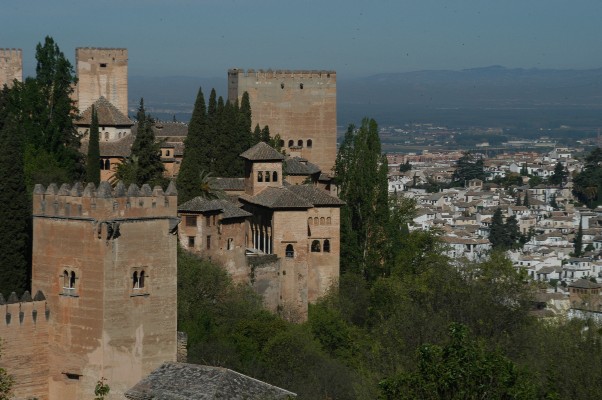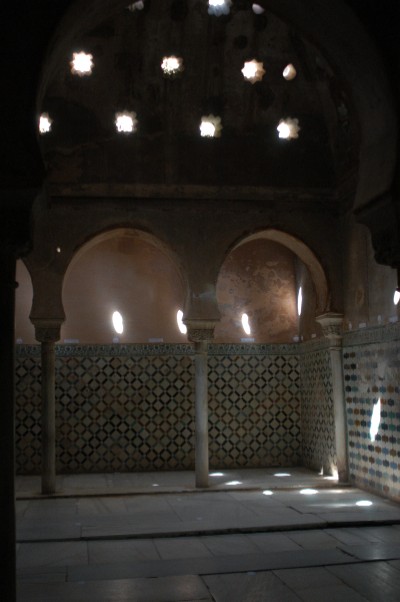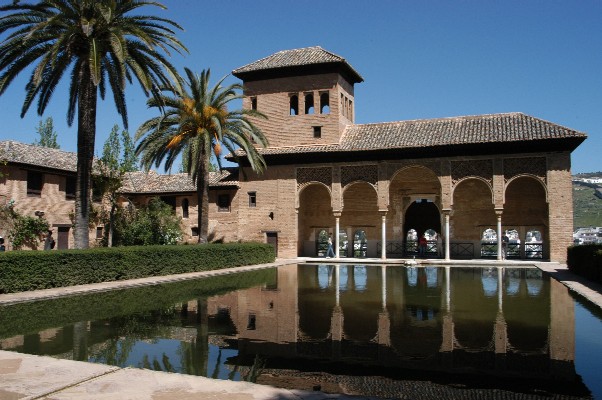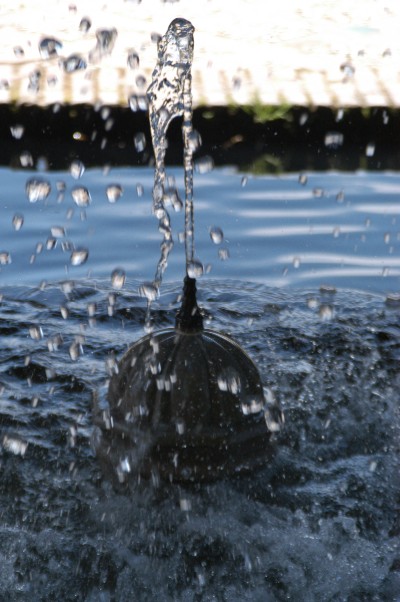THE ALHAMBRA "Part Three" Exiting the Courtyard of the Myrtles we entered the Alhambra's most unique structure, the Palace and Courtyard of the Lions. This was the center of the Sultans private dwellings and featured an elaborate colonnaded courtyard with pavilions jutting out from the ends. In the center stood a large fountain supported by lions that once poured water into narrow troughs that cut across the courtyard. Quite different in feel from the subtle reflecting pool of the Courtyard of the Myrtle, the Courtyard of the Lions was thought to have been inspired by the colonnaded courtyards of Benedictine monasteries. The Sultan who built the palace spent time exiled in Spain and perhaps was influenced by the architectural style. The pillars around the courtyard were once gilded but today remain in white marble. An inscription by the famous poet Ibn Zamrak, around the bowl held by the Lions, read: elaborate colonnaded courtyard with pavilions jutting out from the ends. In the center stood a large fountain supported by lions that once poured water into narrow troughs that cut across the courtyard. Quite different in feel from the subtle reflecting pool of the Courtyard of the Myrtle, the Courtyard of the Lions was thought to have been inspired by the colonnaded courtyards of Benedictine monasteries. The Sultan who built the palace spent time exiled in Spain and perhaps was influenced by the architectural style. The pillars around the courtyard were once gilded but today remain in white marble. An inscription by the famous poet Ibn Zamrak, around the bowl held by the Lions, read:
"Blessed be He who gave the Iman Mohammad mansions adorned so magnificently. Do we not have here in this garden a work so beautiful as to be unrivalled in all God's creations. The glistening pearls of which she is made have often overflowed into her very substance. Liquid silver, incomparable in its whiteness and brilliance, flows between here jewels. To the eye the molten sliver and the solid jewels become entwined so that it is impossible to say which of them is flowing. See how the water laps against the rims of the channels, to be hidden moments later underground, just as a lover tries to keep the tears in his eyes from betraying him. And truly, is she not like a cloud who pours down her beneficence onto the lions. And in the same way, the hand of the caliph, from the first light of dawn, does he not also pour his bounty upon the lions of war,,," .
The system of water throughout the Alhambra was an  elaborate feat of early engineering. Water was channeled off of the river flowing from the Sierra Nevada and the momentum of the water generated enough pressure to feed the various fountains and baths throughout the complex. The lower position of the Alhambra along the ridge was a deliberate part of this water architecture. elaborate feat of early engineering. Water was channeled off of the river flowing from the Sierra Nevada and the momentum of the water generated enough pressure to feed the various fountains and baths throughout the complex. The lower position of the Alhambra along the ridge was a deliberate part of this water architecture.
Off of the courtyard were three rooms, the first of which was the Hall of the Abencerrages, named after an important family that was said to have been slaughtered there for treason. The red stains in the low fountain are rumored to be from their blood. The ceiling was an incredible star shaped dome constructed entirely of mocarabes, dangling like icicles from the ceiling. Small fleur-de-lis of the Bourbon King Pedro could be seen in the individual pieces, a tribute to the Spanish King who gave the Sultan exile. On the far end of the courtyard was a long room that contained several painted alcoves, a rare feature in the Alhambra. The last room was called the Hall of Two Sisters after the two massive pieces of marble that make up the center of the floor. The elaborate mocarabe ceiling in the room was made of 5,416 separate stucco pieces. And, like the Hall of Ambassadors, the room was aligned from north to south so the columns became points on a sundial and the eaves allowed more light to enter in the winter, for warmth, and less in the summer.
From the Hall of Two Sisters the palace complex took a dramatic change into a wing constructed by Charles V.  Like the Palacio de Carlos V that was attached to the entrance of the palaces this Mirador of Lindaraja was done in the contemporary style of King Charles. In contrast to the detail of the Moorish palaces the area was more sedate and stiff. The relatively low ceilings were covered in dark wood, some with colorful paintings, giving the wing a cozier feel. It was in these rooms that Washington Irving set up residence during his time at the Alhambra. Like the Palacio de Carlos V that was attached to the entrance of the palaces this Mirador of Lindaraja was done in the contemporary style of King Charles. In contrast to the detail of the Moorish palaces the area was more sedate and stiff. The relatively low ceilings were covered in dark wood, some with colorful paintings, giving the wing a cozier feel. It was in these rooms that Washington Irving set up residence during his time at the Alhambra.
The Mirador of Lindaraja surrounded a courtyard on three sides with the Hall of Two Sisters comprising the fourth side. Underneath the Hall of Two Sisters, on ground level with the more typically European style garden, was a bathhouse. Bathhouses were more than just a place to bathe but were also a place where business was conducted. The bathhouse came second only to the mosque and served the social purpose that a town square or market place did in other cultures. Washing was an important part of the religion which dictated that people wash before entering the mosque, before and after meals, after touching dirty things, after the toilet, before touching the Quran, and other specified occasions. The room was lit by star shaped holes in the domed ceiling. These holes originally had removable red glass covers that allowed heat to be released from the bathhouse. In typical Islamic form, the bathhouse had a cold room, warm room, and a hot room. The hot room was naturally the closest to the furnaces. This model was essentially taken from the early Roman bathhouses. The Alhambra at one time had up to a dozen or more bathhouses, public and private, to support is 1500-2000 person population. Alhambra at one time had up to a dozen or more bathhouses, public and private, to support is 1500-2000 person population.
At this point the tour of the palaces came to an end and we left the last courtyard to enter the expansive Partal, or palace gardens. The gardens have been mostly reconstructed but ruins of the Palace of Yusuf III have left the original reflecting pools in place and the outer wall of the Palace of the Portico still overlooks Albayzin, its tower and arches reflected in a large reflecting pool. The tiered garden with open spaces made for excellent strolling after the crowded tour of the palaces. Stretching down the length of the Partal was the outer wall of the Alhambra with its original towers. The towers were one of the earliest structures, built in the 13th century, after the Alcazaba fortress and before the palaces. A couple of the towers are featured in tales about the Alhambra and have been given the names the Tower of the Captive Princess and the Tower of the Princesses, where there sisters were said to have been kept under lock and key by the Sultan to protect them from dangerous fates foretold by the astrologers. Doubling as housing as well as fortifications the towers are supposed to be like small palaces in themselves but they weren't open to the public. |
SPAIN
Madrid
Mar 23
Mar 24
Mar 25-26
Mar 27-30
Granada
Mar 31
April 1-28
Semana Santa
Part I
Part II
Photos I
Photos II
Photos III
Photos IV
The Alhambra
Part I
Part II
Part III
Part IV
GIBRALTAR
April 29
MOROCCO
Chefchaouen
April 30
May 1
Fes
May 2
May 3
May 4
May 5
May 6
Meknes
May 7
May 8
May 9
Sahara
May 10-11
May 12
May 13-14
May 15
Marrakesh
May 16
|

